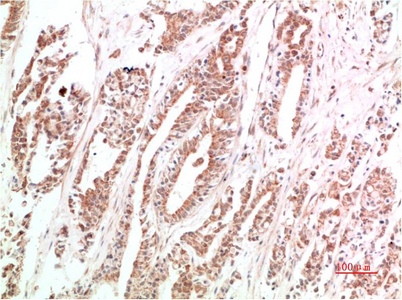VEGF Rabbit Polyclonal Antibody
- Catalog No.:YN5444
- Applications:IF;WB;IHC;ELISA
- Reactivity:Human;Rat;Mouse
- Target:
- VEGF
- Fields:
- >>EGFR tyrosine kinase inhibitor resistance;>>MAPK signaling pathway;>>Ras signaling pathway;>>Rap1 signaling pathway;>>Calcium signaling pathway;>>HIF-1 signaling pathway;>>PI3K-Akt signaling pathway;>>VEGF signaling pathway;>>Focal adhesion;>>Relaxin signaling pathway;>>AGE-RAGE signaling pathway in diabetic complications;>>Human cytomegalovirus infection;>>Human papillomavirus infection;>>Kaposi sarcoma-associated herpesvirus infection;>>Pathways in cancer;>>Proteoglycans in cancer;>>MicroRNAs in cancer;>>Chemical carcinogenesis - receptor activation;>>Chemical carcinogenesis - reactive oxygen species;>>Renal cell carcinoma;>>Pancreatic cancer;>>Bladder cancer;>>Rheumatoid arthritis;>>Fluid shear stress and atherosclerosis
- Gene Name:
- VEGFA
- Protein Name:
- VEGFA
- Human Gene Id:
- 7422
- Human Swiss Prot No:
- P15692
- Mouse Swiss Prot No:
- Q00731
- Rat Swiss Prot No:
- P16612
- Immunogen:
- Recombinant Protein of VEGF of VEGFA
- Specificity:
- VEGF protein detects endogenous levels of VEGFA
- Formulation:
- Liquid in PBS containing 50% glycerol, 0.5% BSA and 0.02% sodium azide.
- Source:
- Polyclonal, Rabbit,IgG
- Dilution:
- IF 1:50-200 WB 1:500-2000, IHC 1:50-300 IHC 1:50-300
- Purification:
- The antibody was affinity-purified from rabbit antiserum by affinity-chromatography using epitope-specific immunogen.
- Concentration:
- 1 mg/ml
- Storage Stability:
- -15°C to -25°C/1 year(Do not lower than -25°C)
- Other Name:
- VEGFA
- Observed Band(KD):
- 21kD(monomer),42kD(dimer)
- Background:
- This gene is a member of the PDGF/VEGF growth factor family. It encodes a heparin-binding protein, which exists as a disulfide-linked homodimer. This growth factor induces proliferation and migration of vascular endothelial cells, and is essential for both physiological and pathological angiogenesis. Disruption of this gene in mice resulted in abnormal embryonic blood vessel formation. This gene is upregulated in many known tumors and its expression is correlated with tumor stage and progression. Elevated levels of this protein are found in patients with POEMS syndrome, also known as Crow-Fukase syndrome. Allelic variants of this gene have been associated with microvascular complications of diabetes 1 (MVCD1) and atherosclerosis. Alternatively spliced transcript variants encoding different isoforms have been described. There is also evidence for alternative translation initiation fro
- Function:
- function:Growth factor active in angiogenesis, vasculogenesis and endothelial cell growth. Induces endothelial cell proliferation, promotes cell migration, inhibits apoptosis, and induces permeabilization of blood vessels. Binds to the VEGFR1/Flt-1 and VEGFR2/Kdr receptors, heparan sulfate and heparin. Neuropilin-1 binds isoforms VEGF-165 and VEGF-145. Isoform VEGF165B binds to VEGFR2/Kdr but doesn't activate downstream signaling pathways, doesn't activate angiogenesis and inhibits tumor growth.,induction:Regulated by growth factors, cytokines, gonadotropins, nitric oxide, hypoxia, hypoglycemia and oncogenic mutations.,online information:VEGF entry,similarity:Belongs to the PDGF/VEGF growth factor family.,subcellular location:VEGF121 is acidic and freely secreted. VEGF165 is more basic, has heparin-binding properties and, although a signicant proportion remains cell-associated, most is f
- Subcellular Location:
- Secreted . VEGF121 is acidic and freely secreted. VEGF165 is more basic, has heparin-binding properties and, although a significant proportion remains cell-associated, most is freely secreted. VEGF189 is very basic, it is cell-associated after secretion and is bound avidly by heparin and the extracellular matrix, although it may be released as a soluble form by heparin, heparinase or plasmin.
- Expression:
- Isoform VEGF189, isoform VEGF165 and isoform VEGF121 are widely expressed. Isoform VEGF206 and isoform VEGF145 are not widely expressed. A higher level expression seen in pituitary tumors as compared to the pituitary gland.
LncRNA TUG1 Promotes Apoptosis, Invasion, and Angiogenesis of Retinal Endothelial Cells in Retinopathy of Prematurity via MiR-145-5p. Frontiers in Medicine2022 Apr 4;9:803214. Mouse 1:200 retinal tissue
The Long-Noncoding RNA TUG1 Regulates Oxygen-Induced Retinal Neovascularization in Mice via MiR-299 Invest Ophth Vis Sci. 2022 Jan;63(1):37-37. WB,IF,IHC Mouse 1:1000,1:200,1:200 retina
Hypoxia-induced miR-210 promoter demethylation enhances proliferation, autophagy and angiogenesis of schwannoma cells. ONCOLOGY REPORTS 2017 Mar 16 WB,IHC Rat 1:100 schwannoma tissues RT4-D6P2T cell
TGF-α Overexpression in Breast Cancer Bone Metastasis and Primary Lesions and TGF-α Enhancement of Expression of Procancer Metastasis Cytokines in Bone Marrow Mesenchymal Stem Cells. Biomed Research International Biomed Res Int. 2018;2018:6565393 IHC Human 1 : 100 Breast cancer bone metastasis
Sprayed copper peroxide nanodots for accelerating wound healing in a multidrug-resistant bacteria infected diabetic ulcer. Nanoscale Nanoscale. 2021 Oct;13(37):15937-15951 WB Human HUVECs
Marine bromophenol bis(2,3-dibromo-4,5-dihydroxybenzyl) ether, represses angiogenesis in HUVEC cells and in zebrafish embryos via inhibiting the VEGF signal systems. BIOMEDICINE & PHARMACOTHERAPY 2015 Sep 07 WB Human HUVECs
Down-regulation of FoxM1 by thiostrepton or small interfering RNA inhibits proliferation, transformation ability and angiogenesis, and induces apoptosis of nasopharyngeal carcinoma cells. International Journal of Clinical and Experimental Pathology Int J Clin Exp Patho. 2014; 7(9): 5450–5460 WB Human Nasopharyngeal carcinoma (NPC) cell
Marine bromophenol bis (2, 3-dibromo-4, 5-dihydroxybenzyl) ether, represses angiogenesis in HUVEC cells and in zebrafish embryos via inhibiting the VEGF signal systems." Biomedicine & Pharmacotherapy 75 (2015): 58-66.
Marine bromophenol bis (2, 3-dibromo-4, 5-dihydroxybenzyl) ether, represses angiogenesis in HUVEC cells and in zebrafish embryos via inhibiting the VEGF signal systems." Biomedicine & Pharmacotherapy 75 (2015): 58-66.
Hypoxia-induced miR-210 promoter demethylation enhances proliferation, autophagy and angiogenesis of schwannoma cells. ONCOLOGY REPORTS 2017 Mar 16 WB,IHC Rat 1:100 schwannoma tissues RT4-D6P2T cell
Hypoxia-induced miR-210 promoter demethylation enhances proliferation, autophagy and angiogenesis of schwannoma cells. ONCOLOGY REPORTS 2017 Mar 16 WB,IHC Rat 1:100 schwannoma tissues RT4-D6P2T cell
Losartan protects against intermittent hypoxia-induced peritubular capillary loss by modulating the renal renin–angiotensin system and angiogenesis factors. ACTA BIOCHIMICA ET BIOPHYSICA SINICA Acta Bioch Bioph Sin. 2020 Jan;52(1):38-48 WB Rat 1:500 Kidney cortex
Itaconic acid induces angiogenesis and suppresses apoptosis via Nrf2/autophagy to prolong the survival of multi-territory perforator flaps. Liming Qing WB Rat 1:1000 flap tissue
- June 19-2018
- WESTERN IMMUNOBLOTTING PROTOCOL
- June 19-2018
- IMMUNOHISTOCHEMISTRY-PARAFFIN PROTOCOL
- June 19-2018
- IMMUNOFLUORESCENCE PROTOCOL
- September 08-2020
- FLOW-CYTOMEYRT-PROTOCOL
- May 20-2022
- Cell-Based ELISA│解您多样本WB检测之困扰
- July 13-2018
- CELL-BASED-ELISA-PROTOCOL-FOR-ACETYL-PROTEIN
- July 13-2018
- CELL-BASED-ELISA-PROTOCOL-FOR-PHOSPHO-PROTEIN
- July 13-2018
- Antibody-FAQs
- Products Images

- Immunohistochemical analysis of paraffin-embedded Human Stomach Carcinoma Tissue using VEGF Rabbit pAb diluted at 1:500.



